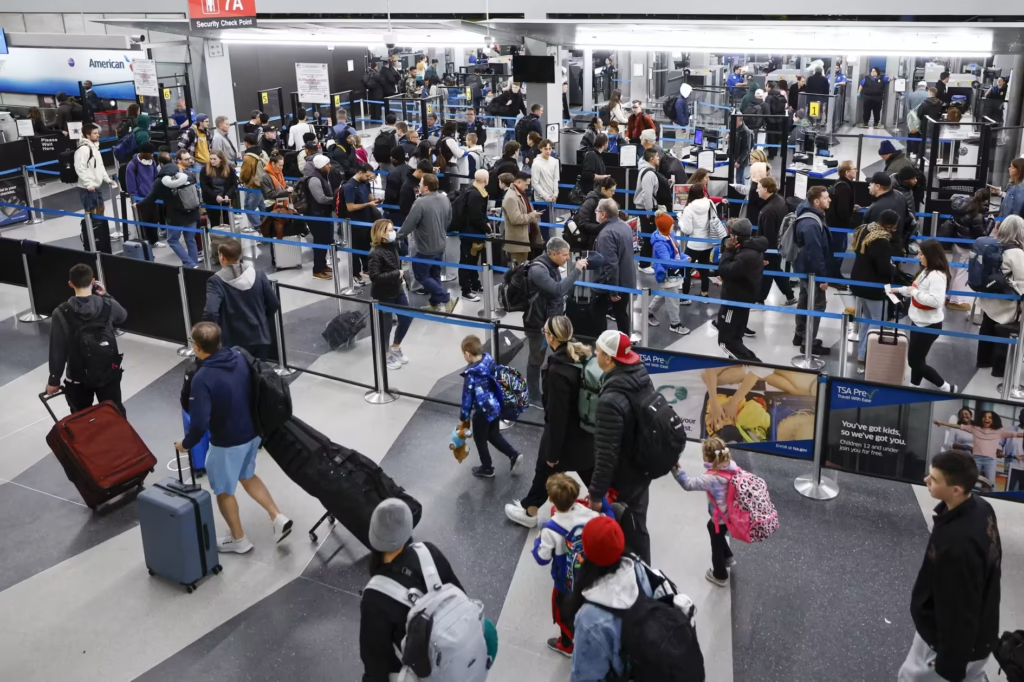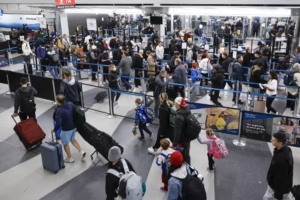December travelers in Chicago’s O’Hare airport. According to an aviation analytics firm, if shutdown-related systemwide cuts are put into place on Friday, over 1,800 flights will be canceled.
Following the announcement that the United States will reduce aircraft capacity at 40 of the country’s airports by 10% on Friday if the shutdown persists, an aviation analytics firm has done some calculations.
At a press meeting late Wednesday, Transportation Secretary Sean Duffy announced the news, stating that the administration was taking action to ensure the safety of air travel and that the identities of the affected airports would be made public on Thursday.
It is “very rough math,” a spokeswoman for the company, Cirium, stated on Wednesday. For instance, regional trips on smaller aircraft have fewer seats than long-haul flights on widebody planes.
However, only three weeks before Thanksgiving week, which is always the busiest for air travel and travel in general, the experiment depicts heightened pain for air travelers.
According to Cirium, the announced reduction might result in the cancellation of up to 1,800 flights on Friday and the loss of almost 268,000 seats that were originally planned to operate on that day.
Like the rest of the country, it stated that it has yet to learn from the FAA which airports will be affected and how the 10% cuts will be implemented, such as if they will only effect domestic flights or international ones.
According to Cirium, a 10% reduction at Chicago’s O’Hare, the country’s busiest airport by departures, would result in the cancellation of roughly 14,500 seats and 121 flights on Friday.
There would be 104 fewer flights and 17,100 fewer seats available at Atlanta’s Hartfield-Jackson Airport, the second-busiest. Denver’s airport would lose 95 flights, and Dallas-Forth Worth’s would lose 96. 72 fewer flights, or more than 12,000 seats, would be available at Los Angeles’ airport, which is the fifth-busiest by departures.
Phoenix, Houston, and Charlotte, North Carolina, will lose over 60 flights on Friday. On Friday, the three airports in the New York City area—Newark, JFK, and LaGuardia—would lose between 50 to 60 flights.
Air traffic controllers only got a partial wage in mid-October and missed their first paycheck last week. They are among the federal employees who are deemed vital and are anticipated to continue working throughout the shutdown, along with airport screeners.
But they might be missing work more and more. In recent days, some flights have been canceled or delayed due to “staffing triggers,” which indicate a lack of controllers, in addition to the more common halts caused by inclement weather or construction at U.S. airports.
As paychecks continue to be delayed, it is anticipated that staffing triggers will rise during the remainder of the week.
The closure has already surpassed the 35-day 2018–19 shutdown as the longest shutdown ever. One of the pivotal events that led to the termination of the closure was a ground stop to and from LaGuardia airport in New York City in January 2019.
President Donald Trump and his Republicans were at odds with Democratic lawmakers about whether to include an extension for Obamacare subsidies in a package to fund the federal government through November 21. This was the main reason the shutdown started on October 1.





